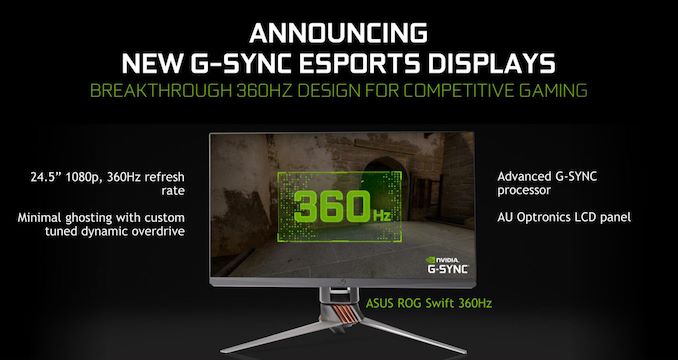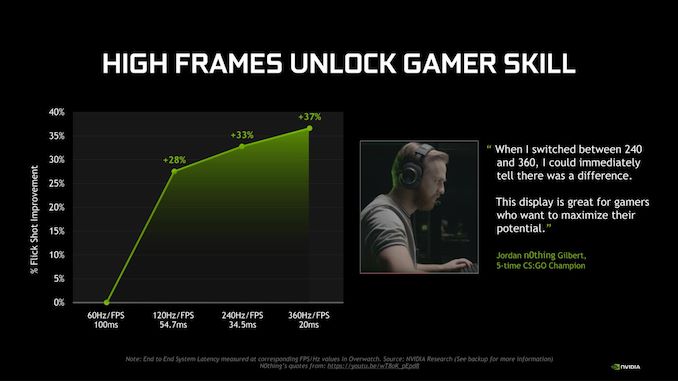NVIDIA & ASUS Unveil 360Hz 1080p G-Sync Monitor: ROG Swift 360
by Ryan Smith on January 5, 2020 9:00 PM EST- Posted in
- Monitors
- Asus
- ROG
- 1080p
- Trade Shows
- NVIDIA
- G-Sync
- AU Optronics
- CES 2020
- 360Hz

Even though CES proper doesn’t kick off for one more day, NVIDIA and ASUS are getting in an announcement a bit ahead of the curve relating to a new monitor. The two companies have been working on a new high-performance 1080p display aimed at competitive gaming that offers a blistering 360Hz maximum refresh rate, 50% faster than the current crop of 240Hz market leaders. The new monitor will be sold by ASUS as the ROG Swift 360, and is set to be available later this year.
Like other G-Sync projects, NVIDIA’s latest display endeavor looks to be an effort for the company to differentiate itself and its technology in a crowded market, this time by offering an LCD monitor with a rather absurd refresh rate.
The ROG Swift 360 itself is based on a 24.5-inch panel being supplied by AU Optronics, and which is capable of running at up to 360Hz. This is 120Hz faster than the current generation of high-end gaming monitors, which top out at 240Hz, and is an uncommonly large jump to make in a single generation. Unfortunately NVIDIA isn’t disclosing what type of panel is being used here, however all of the 24.5-inch 240Hz G-Sync monitors that have been released to date have been TN, so that’s a safe bet, especially with the kind of refresh rate NVIDIA and ASUS are looking to hit. The bigger question is whether this is a new panel from AUO, or if it’s a further overclocked version of their popular M250HTN01 panel.
NVIDIA and ASUS have not released much else with regards to technical details at this time. The monitor isn’t set to ship until later this year – which as we’re at the very start of the year, likely means it’s still several months off – so the companies undoubtedly still have some technical details to hammer out. Though as most of the work is in the panel and controller, it shouldn’t be too different from ASUS’s 240Hz ROG Swift PG258Q.

ASUS 360 Hz on left, 240 Hz on right. It is a TN Panel
One thing that NVIDIA has confirmed, however, is that this will be a true G-Sync monitor, with NVIDIA supplying the monitor’s display controller. This is an important distinction not only for compatibility purposes, but because it means that the monitor supports full variable overdrive functionality, which will become increasingly important with such a wide refresh rate range. Even fast TN monitors still need to overdrive their pixels to hit high refresh rates, so the overdrive logic is practically as important as the panel itself in order to minimize ghosting. Though it goes without saying that with NVIDIA aiming to beat current generation monitors by 50%, it’ll be interesting to see just how well 360Hz works in practice, and if the monitor really is fast enough to make a 360Hz refresh rate useful.
The target market for the ROG Swift 360, in turn, is competitive gaming, as well as anyone who wants a competition-grade monitor. The benefits of higher refresh rates are pretty well known at this point – higher refresh rates make for smoother experiences and reduce rendering latency – and NVIDIA thinks that there’s still enough benefit to justify a 360Hz monitor. That said, with 240Hz monitors offering an already tiny 4.16ms frame time, the absolute benefit of 360Hz is small: that 50% jump in refresh rate only shaves off a further ~1.4ms at the monitor level (for a total of 2.77ms), which isn’t nearly as great as the jump from 60Hz to 120Hz, for example.
Still, NVIDIA has done their own research around the new monitor and player performance, finding that even with the diminishing returns, a 360Hz monitor did improve flick shot performance in Overwatch. As well, they measured a 14.5ms reduction in total (end-to-end) latency, going from 34.5ms at 240Hz to 20ms at 360Hz.
NVIDIA and ASUS will have the ROG Swift 360 on display this week at CES. So while the monitor won’t be on sale for a while yet, we should be able to get a first-hand look at how well NVIDIA’s future gaming monitor is set to perform.
Source: NVIDIA











38 Comments
View All Comments
Awful - Monday, January 6, 2020 - link
willis936 - actually sounds more like blurbusters than tftcentralSirDragonClaw - Sunday, January 5, 2020 - link
Nice, now tell me when they release a 1440p one at 300+ fps. Then I will buy it regardless of price.But this is very good for the state of the industry.
isthisavailable - Sunday, January 5, 2020 - link
Can most game engines even output 360 fps? Most of them have a cap at like 200 fps.lilkwarrior - Monday, January 6, 2020 - link
You don't make a monitor supposed to last 3-5 years after you purchase it merely on today's market for the monitor. That's frankly moronic. Also the hardware needs to proceed the software that utilizes the hardware—especially by-the-numbers-oriented developers like game developers.It's the same weird logic people had issues w/ Nvidia RTX series that is faulty: Game developers can't & won't make games leveraging ray-tracing if there's no GPUs available for mass consumers in addition to themselves + consoles. That's played itself exactly like what most expected besides the strong cynicism by gamers with no next-gen console information on the horizon when such GPUs launched (outside of their control); that's since been predictably corrected with Xbox One Series X's & PS5's ray-tracing support.
Same thing will happen for this especially now that Windows 7 is EOL'd, all modern GPUs will get a significant bump with new games during the lifecycle of this monitor being sold to be able to run 360hz
Alistair - Monday, January 6, 2020 - link
ray tracing is dumb (Control with RT off had no window reflections even though there were many ways to accomplish it without ray tracing such as planar reflections and screen space reflections) and a waste of resources (opportunity cost of silicon area and money) that would be better spent on other parts of the silicon which is why people don't like it, there's no faulty logic i assure youEliadbu - Monday, January 6, 2020 - link
No it's just matter of time, like all new technologies in graphics it will take time to developers to implement all features and hardware to be powerful enough to back it up, those things take years. And it is part of on going path of getting more realistic graphics in real time rendering.Spunjji - Monday, January 6, 2020 - link
The pushback against RTX was mainly for 3 reasons:1) The initial implementation doesn't perform well.
2) Introducing it on the 14nm node bloated the costs of their products.
3) Pushing it as far down the stack as the 2060 exacerbated (1) and (2) for cost-sensitive buyers - to get the substantial performance benefits of Turing, you are forced to invest in what is - at that level - a completely useless feature that does very little now and will never perform well enough for the future games that (may) eventually use it better. The same's true for the 2070 for anybody who already invested in a 1440p or better display.
SeannyB - Monday, January 6, 2020 - link
Even without a cap, a lot of games would hit single-threaded CPU performance limits before reaching 360 FPS. Like with 240Hz displays, these are made for only a handful of games.PeachNCream - Monday, January 6, 2020 - link
Thank goodness for the fate of humanity that this statement is correct and that only a really stupid handful of a niche of people will lust after this product.willis936 - Monday, January 6, 2020 - link
The only real reason most games can’t, in theory, run at arbitrarily high frame rates is because animation is hard work and without care to specifically ensure frame rate scalability, the animations may only look good at certain frame rates (look at halo reach on PC at frame rates above 60 fps). We’ve (mostly, not entirely) moved past physics engines and rendering engines being in lockstep.